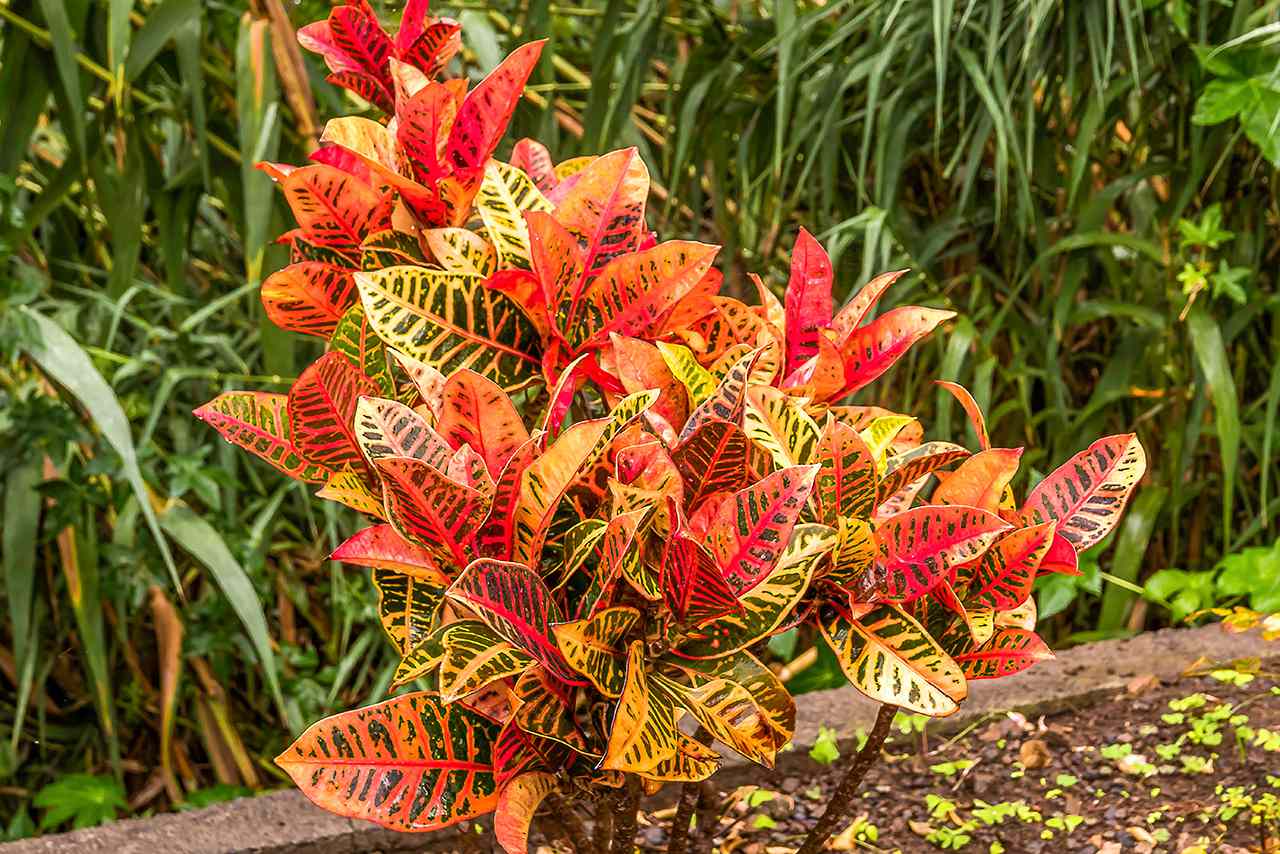
Croton, also known as Codiaeum variegatum, is a stunning and vibrant plant that is sure to catch anyone’s eye. With its strikingly colorful leaves and unique patterns, croton has become a popular choice for both indoor and outdoor gardens. But there’s more to this plant than meets the eye. In this article, we will explore 20 astonishing facts about croton that will not only amaze you but also deepen your appreciation for this remarkable plant. From its origins in tropical regions to its medicinal and cultural significance, croton continues to captivate plant enthusiasts all over the world. So, let’s dive in and discover the intriguing world of croton!
Key Takeaways:
- Croton plants have stunning, colorful leaves and are easy to care for. They can purify the air and bring good luck, but keep them away from pets as they are toxic.
- Croton is a diverse, tropical plant used for landscaping and natural dyes. Its year-round vibrant foliage adds a touch of tropical elegance to indoor spaces.
Croton is a diverse plant genus.
Croton is a large and diverse genus of flowering plants in the spurge family, Euphorbiaceae. It comprises around 750 known species, making it one of the most diverse plant groups.
Croton leaves are highly decorative.
The leaves of Croton plants come in a variety of stunning shapes and colors. From vibrant shades of red, orange, and yellow to bold patterns and intricate designs, Croton leaves can add a striking touch to any indoor or outdoor space.
Croton is native to tropical regions.
Most species of Croton are native to tropical regions, including parts of Africa, Asia, and the Americas. These plants thrive in warm and humid climates, making them popular choices for gardens and indoor plant collections in such areas.
Croton is known for its air-purifying properties.
Croton plants are not only aesthetically pleasing, but they also help improve the air quality by absorbing harmful pollutants and releasing oxygen. This makes them great additions to any indoor space, especially in urban environments.
Croton is used in traditional medicine.
Various parts of the Croton plant have been used in traditional medicine for centuries. Extracts from the leaves, roots, and seeds are believed to possess medicinal properties and have been utilized in the treatment of various ailments.
Croton is a low-maintenance plant.
Despite its exotic appearance, Croton is relatively easy to care for. It requires well-draining soil, regular watering, and moderate sunlight to thrive. With proper care, it can be a long-lasting and visually appealing addition to your plant collection.
Croton is toxic to pets.
While Croton plants are beautiful, it’s important to note that they can be toxic to cats, dogs, and other pets if ingested. Keep them out of reach of curious pets to ensure their safety.
Croton is a popular choice for landscaping.
With their vibrant foliage and various growth habits, Croton plants are often used in landscaping projects to add color and visual interest. They work well as focal points, hedges, or even as container plants.
Croton can be propagated from stem cuttings.
If you’re looking to expand your Croton collection, you can easily propagate new plants from stem cuttings. Simply cut a healthy stem, remove the lower leaves, and place it in a well-draining potting mix. With proper care, roots will develop, and a new plant will grow.
Croton comes in dwarf varieties.
For those with limited space or who prefer smaller plants, there are dwarf varieties of Croton available. These compact plants still showcase the stunning colors and patterns of their larger counterparts but in a more manageable size.
Croton is used in the production of natural dyes.
The vibrant colors found in Croton leaves have been used for centuries in the production of natural dyes. Various shades of yellow, red, and orange can be extracted from different species of Croton and used to dye fabrics and fibers.
Croton can grow up to several feet tall.
Depending on the species and growing conditions, Croton plants can reach impressive heights. Some varieties can grow up to several feet tall, creating a dramatic and eye-catching presence in any landscape.
Croton is a symbol of good luck and prosperity.
In certain cultures, Croton is considered a symbol of good luck and prosperity. It is believed to bring positive energy and abundance into the home or workplace, making it a popular gift for housewarmings and other special occasions.
Croton is resistant to pests.
One of the advantages of growing Croton plants is that they are relatively resistant to common pests. However, it’s still essential to keep an eye out for signs of infestation and take necessary measures to prevent any potential problems.
Croton leaves change color with age.
As Croton leaves mature, their colors can change and become more intense. This adds an element of visual interest to the plant, as different shades and patterns can be seen on the same foliage.
Croton is used in landscaping for its year-round color.
Unlike many other plants that only provide color during a specific season, Croton is known for its year-round color display. Its evergreen foliage ensures that your garden or indoor space remains vibrant and lively, regardless of the time of year.
Croton is often used as a border plant.
With its dense foliage and striking colors, Croton is commonly used as a border plant to create visually appealing edges in gardens and landscapes. Its contrasting hues can help define and highlight different areas of the landscape.
Croton is a popular choice for indoor décor.
Croton plants have become a popular choice for indoor décor due to their vibrant and eye-catching foliage. They can instantly brighten up any room and add a touch of tropical elegance to the overall ambiance.
Croton is drought-tolerant.
While Croton plants require regular watering, they have a certain level of drought tolerance. This makes them suitable for regions with limited water resources or for individuals who may sometimes forget to water their plants.
Croton flowers are small and inconspicuous.
Although Croton plants produce flowers, they are generally small and less noticeable compared to the vibrant leaves. The flowers are usually greenish-yellow in color and are not the primary feature that makes Croton attractive.
Conclusion
In conclusion, croton plants are truly remarkable in many ways. From their stunning foliage to their wide range of colors and patterns, crotons add a unique and vibrant touch to any garden or indoor space. Whether you’re a beginner gardener or a seasoned plant enthusiast, incorporating crotons into your collection is a surefire way to elevate the overall aesthetics of your environment. Not only are they visually appealing, but crotons also have air-purifying properties, making them a great choice for improving indoor air quality.
With their ability to thrive in warm climates, low maintenance requirements, and versatility in being grown both indoors and outdoors, crotons are a fantastic addition to any plant lover’s assortment. So, why wait? Bring the enchanting beauty of crotons into your life and enjoy the countless benefits they have to offer!
FAQs
1. How often should I water my croton plant?
The watering frequency for croton plants depends on various factors such as temperature, humidity, and soil moisture levels. It is essential to check the top inch of soil before watering. Generally, it is recommended to allow the soil to dry out slightly between waterings, ensuring it’s not overly saturated.
2. Can croton plants be grown indoors?
Absolutely! Croton plants can thrive indoors with the right conditions. They prefer bright, indirect light and a warm environment. Placing them near a window with filtered sunlight or using artificial grow lights can help them flourish indoors. Additionally, maintaining adequate humidity levels is crucial for their well-being.
3. Are crotons toxic to pets?
Yes, croton plants are toxic to pets if ingested. They contain compounds that can cause gastrointestinal irritation, vomiting, and excessive drooling. It is essential to keep croton plants out of reach of curious pets and seek immediate veterinary assistance if you suspect your pet has ingested any part of the plant.
4. How can I propagate my croton plant?
Croton plants can be propagated through stem cuttings. Take a 4-6 inch piece of healthy stem from the parent plant, remove the lower leaves, and place the cutting in a well-draining potting mix. Keep the soil slightly moist and provide warmth and indirect sunlight. The cutting should root within a few weeks.
5. Do croton plants require any special care?
Croton plants require bright light, warm temperatures, and high humidity to thrive. It’s important to monitor the moisture levels in the soil and avoid overwatering. Regularly dusting the plants’ leaves to remove any debris and misting them to increase humidity can promote healthy growth. Pruning the plant to maintain its shape and remove any dead or damaged leaves is also beneficial.
Croton plants captivate with their astonishing facts, but there's more to explore! Uncover the mindblowing truths about garden croton, from its vibrant leaves to surprising growth habits. Football enthusiasts will enjoy learning 22 fascinating facts about FC Crotone, a Italian club with a rich history. Stadio Ezio Scida, home to FC Crotone, holds 13 extraordinary secrets waiting to be revealed. Whether you're a plant lover or sports fan, these articles offer intriguing insights into the world of croton and beyond. Dive in and satisfy your curiosity with these engaging reads!
Was this page helpful?
Our commitment to delivering trustworthy and engaging content is at the heart of what we do. Each fact on our site is contributed by real users like you, bringing a wealth of diverse insights and information. To ensure the highest standards of accuracy and reliability, our dedicated editors meticulously review each submission. This process guarantees that the facts we share are not only fascinating but also credible. Trust in our commitment to quality and authenticity as you explore and learn with us.


